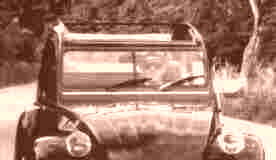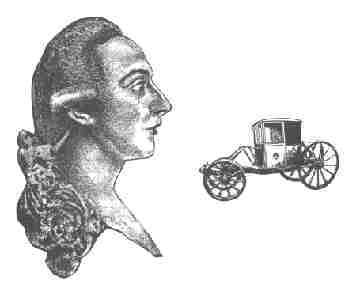

THE CASANOVA TOUR
by Pablo Günther
TRAVELLING CARRIAGES - (part III, V - VIII) - Casanova's Carriages - List of Casanova's carriages - 1. Cesena - 2. Geneva 1 - 3. Paris 1 - 4. Paris 2 - 5. Zurich - 6. Pisa - 7. Aachen - (continuation: part VII )
The Lister Chaise. Photo: PG.no. name*... year ... wheels/seats ... type ......................... kilometres
[* Corresponding to the town, where the carriages - all second hand - were bought.]
I. Travelling carriages from 1749 until 1772:
7 Coupés, 4 Chaises de Poste, 1 open carriage, 1 coach, 1 sleeping carriage.
The English Coupés or Post Chariots: 36.6 % or 8,160 km of 22,265 km altogether.
1. Cesena ....... 1749 ... 4/2 ..... English Coupé ......................... 985
2. Geneva 1 .... 1750 ... 4/2 ..... English Coupé ........................ 755
3. Paris 1 ....... 1757 ... 2/1 ...... Chaise de Poste ..................... 1,505
4. Paris 2 ....... 1759 ... 2/1 ...... Chaise de Poste ..................... 1,120
5. Zurich ........ 1760 ... 4/4 ..... Open Carriage ........................ 1,800
6. Pisa ........... 1760 ... 4/2 ...... English Coupé ...................... 4,340
7. Aachen ...... 1762 ... 4/4 ..... Coach (Berlin?) .......................... 155
8. Geneva 2 ... 1762 ... 4/2 ..... English Coupé ....................... 2,080
9. Lyons ........ 1763 ... 2/1 ..... Chaise de Poste, "Solitaire" ...... 1,215
10. Wesel ....... 1764 ... 4/2 ..... Coupé ...................................... 610
11. Riga ......... 1764 ... 4/2 ..... Sleeping Carriage ..................... 3,250
12. Warsaw ... 1766 ... 4/2 ..... Coupé .................................... 2,835
13. Paris 3 ..... 1767 ... 2/1 ..... Chaise de Poste .......................... 755
14. Salerno .... 1770 ... 4/2 ..... Coupé ....................................... 860
..............................................................................................................total: 22,265
II. Two town carriages in Paris: 1758 - 1759. No specification.
III. Travelling carriages from 1773 onwards:
15. Innsbruck .. 1783 .. 4/2 ..... Chaise, "Sedia da posta" ............. 560
16. Paris 4 ...... 1783 .. 4/4 ..... Travelling Coach, "carrozza" .... 1,360
17. Dux .......... 1786 .. 4/2 ..... Travelling calash, "voiture" ....... 2,950
1. The English Coupé "Cesena"I. His Travelling Carriages between 1749 and 1772.
According to my present knowledge, I see this Post Chariot as being the nearest to Casanova's voiture anglaise. It is a convertible coupé, a so-called Landaulet, of which the upper part of the body could be folded back and - presumably - dismantled. - A. Webley, London, 1763. Photo: PG.
Convertible coupé (Post Chaise), the top folded back, the door and front windows let down, the frame of the front window folded forward. - A Webley, London 1763. Photo: PG.
Casanova tells:[Italics, bold print and annotations / translations between [ ] are my own.
In Cesena, a town between Bologna and Rimini (see next picture), Casanova meets Henriette:(HL,vol.III,chapter2,p.21ff.) As her conquest seemed to me no difficult matter I considered how to go about achieving it. (...).
Cesena, Piazza del Popolo. The shadow of the old townhall is visible on the right. The building above the fountain was the posting inn (corner Via Zeffirino) where Casanova lodged and met Henriette. - Photo: Tab Cart, Forli.
Some months later, Casanova accompanied Henriette to Geneva:(HL,III/5,p.75ff.) We set out from Parma at nightfall, and we stopped at Turin for only two hours to engage a manservant to wait on us as far as Geneva. The next day we ascended Mont Cenis in [carried] chairs, then descended to Lanslebourg* by sledge. On the fifth day we reached Geneva and put up at the 'Scales'. (...).
The second oldest drawing of an English Coupé which I know of is this Post-Chaise, designed by Paul Sandby in 1763. - Photo: Windsor Castle, Royal library.
Henriette away, Casanova alone in Geneva:(HL,III/5,p.77) The next day I set out for Italy with a servant whom Monsieur Tronchin gave me. Despite the unfavorable season, I took the route through the [Grand] Saint Bernard, which I crossed in three days on the seven mules required for ourselves, my trunk, and the carriage intended for my beloved [Henriette]. (...). I felt neither hunger nor thirst nor the cold which froze all nature in that terrible part of the Alps.
In Parma again:(P.79) I get up and open my door to him [de la Haye], then go back to bed.
"Chaise de Poste à L'Écrevisse". - Encyclopédie, Paris 1769. Photo: PG.
Journey from Paris to Amsterdam in October 1758:(HL,V/6,p.130) Two hours before reaching Amsterdam in my two-wheeled post chaise ["chaise de poste"] with my servant sitting behind, I meet a four-wheeled carriage ["calèche"], drawn by two horses like mine and also carrying a master and servant. The driver of the four-wheeled carriage wanted my driver to make way for him, mine protested that if he did he would upset me in the ditch, but the other insisted. I address the master, a handsome young man, and ask him to order his driver to make way for me.
"Chaise de Poste à Cul de Singe". - Encyclopédie, Paris 1769. Photo: PG.
Departure from Paris to Amsterdam in September 1759:(HL,V/11,p.263f.) I sold my horses, my carriages, and all my furniture (...).
Departure from Amsterdam to Germany in February 1760; Highway robbery at Cologne:(HL,VI/2,p.41) So I left in my chaise de poste, for which I had sent to Moerdijk (...). I sent back to Paris a Swiss lackey with whom I had started out, keeping only Leduc, who sat behind. (...).
This open two-seater travelling carriage ornaments an Austrian post-map of 1782. - Photo: PG.
In Zurich there were only open carriages:(HL,VI/4,p.94f.) [To Leduc:] "Tell the innkeeper that I want a carriage at my disposal every day for two weeks and a good hire man-servant."
In Grenoble:(HL,VII/3,p.48f.) (...) the caretaker came up to tell me that I would be well advised to travel to Avignon by water, in a comfortable boat on which I could also put my carriage and which would cost me much less. (...).
In Antibes:(HL,VII/4,p.94.) In that city I engaged a felucca to Genoa, and, intending to return to France by the same route, I put my carriage in a stable, under a written agreement to pay six francs [60 d.] a month.
Antibes, two and a half years later:(HL,IX/2,p.43f.) When I was preparing to order post horses so that we could spend the night at Fréjus, a man appears saying that I owe him ten Louis [2,400 d.; 80 d. per month] for the stabling of a carriage which I had left with him almost three years before. I at once remember that it was when I had carried Rosalie off from Marseilles. I laugh, for the carriage was a poor one and not worth even five. I reply that I make him a present of it. He says, he does not want my present, he wants ten louis. (...).
The "Lister Chaise" of the Shibden Hall Museum in Halifax / England. Built about 1755. This type (Post Chaise), however with a coachman's seat (then called a Post Chariot), generally corresponds to Casanova's English Coupés. - Photo: Rosalind Westwood, Shibden Hall Museum.
Purchase of another English Coupé:(HL,VII/7,p.144.) The next day I went to dine in Pisa at the "Hussar" inn, where I stayed for two days. From an Englishman I bought a very pretty carriage which seated two and had a folding seat for two more. It was this Englishman who took me to call on the celebrated poetess Corilla, whom I wanted to meet.
Departure from Rome in December 1760:(HL,VII/9,p.205.) The next morning, after breakfasting well and fondly embracing my brother [Giovanni], I set off in my fine carriage with the Abate Alfani, preceded by Leduc on horseback. I reached Naples at a time when the whole city was in a state of alarm because the fatal volcano was threatening to erupt. At the last post station [Aversa] the post master showed me the will left by his father (...).
The great "robbery" on the post road from Naples to Rome in January 1761:(HL,VII/10,p.235ff.) After showing my generosity to the Duke's household, I left as I had arrived. That nobleman, who died three or four years later, escorted me to the door of my carriage.
Soon after that, in Florence, Casanova 'abducted' La Corticelli in a hired carriage of the post in the direction of Bologna and ordered his servants Leduc and Costa to follow in his coupé "Pisa". They, for their part, were ordered to bring along Corticelli`s mother and her son. The meeting point was a village beyond the Tuscan frontier, and perhaps an additional post station, Monghidoro, at that time called Scaricalasino:(HL,VII/12,p.259f.) We left Florence at eight, and I did not stop until an hour after midnight at a post station in Papal territory, where I had nothing more to fear. The name of the station was "The Ass Unloads"; the name set my feather-brained companion laughing, and we went upstairs. (...).
Turin, May 1761:(HL,VII/13,p.283.) After obtaining a letter of credit on Augsburg I left, and the next day I crossed the Mont Cenis on mules - I, Costa, Leduc, and my carriage. Three days later I reached Chambéry, putting up at the only inn*, where all travellers are obliged to lodge.
"Berline de campagne à cul de singe". The high fore wheels were much better for travelling than the usual small ones of Berlins. - Encyclopédie, Paris 1769. Photo: PG.
Departure from Aachen in two carriages:(HL,VIII/3,p.68.) On the third day I furnished the mother and daughter [Mimi] with traveling clothes, and, in an elegant and roomy berlin which I had secured, we all set out happily from Aix. (...).
Departure from Basle:(HL,VIII/4,p.81.) Everything was ready for the next morning, and we left, Madame d'Urfé and I in the berlin, La Corticelli, her mother, and the two maids in the other carriage. When we reached Besancon Madame d'Urfé left me, taking her servants with her, and the next day I set out for Geneva with the mother and daughter. I put up, as always, at the "Scales".